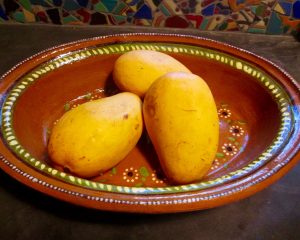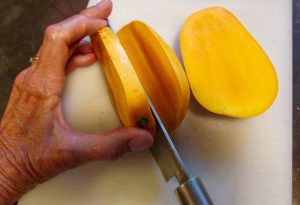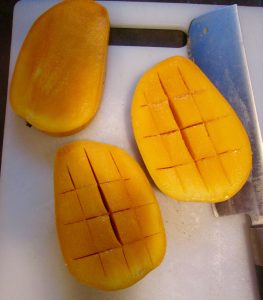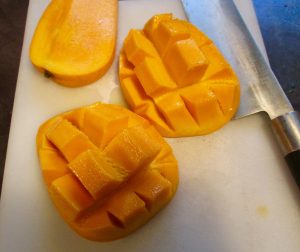Every morning I carefully, thoughtfully, cut up a fragrant, ripe, plump mango and add its meat to my healthy, tropical-fruit, breakfast smoothie. Mangoes, considered the king of fruits, are, hands down, my favorite fruit — way beyond the sweet, summer-fresh Jersey peaches I grew up on. Mangoes, in fact, are one of the many reasons I prefer to live in the tropics — where mangoes grow in profusion.
Mexico is one of the five top mango producers in the world, after India, China, Thailand, and Indonesia. Portuguese explorers in the 16th century are credited with introducing mangoes to Brazil and Africa, after they’d “discovered” the fruit in India. It has since become one of the most widely cultivated fruits in the tropics, with over five hundred varieties known worldwide.
I’ll never forget the first time I discovered mangoes, about a half century ago, when I was in my mid-twenties, living in southern Africa. Walking home from work one day, I noticed what looked to me like the carcass of a huge, fuzzy insect on the sidewalk.
“What’s THAT?!” I asked my co-worker Bev Owen, who was walking beside me.
“That’s just a mango pit, silly,” she said. “Haven’t you ever eaten a mango? They’re lovely! And soooooo juicy! When my sisters and I were little, my mom would put us in the tub, naked, after dinner, give us each a peeled mango, and let us have fun getting totally covered in sweet, sticky mango juice as we ate the luscious fruit as our dessert. Then she’d rinse us off, soap us up, and give us our warm baths before bed.”
I soon made up for my late-in-life introduction to mangoes by eating them at every opportunity.
Back in the States, where mangoes have to travel far from their tropical homelands, I found that this fruit can be pricey. But, I rationalized, using my Mom’s favorite maxim, “It’s better to pay the grocer than the doctor,” mangoes are cheaper than medicine. They’re filled with goodness – high in Vitamins C and A, low in calories, with zero fat – and packed with added benefits, such as helping to facilitate healthy digestion, boost immunity, lower cholesterol, promote eye health, and aid in weight loss.
Years later, when I returned to Africa to live and work, mangoes, which are plentiful and affordable there, always featured prominently in my diet. In the Peace Corps in Gabon, I edited a cookbook for volunteers’ benefit called The Gabon Gourmet (3rd edition, 1997) and included in it as many mango recipes as I could, such as this über-easy one for Mango Frozen Yogurt: Combine 1-1/2 cups freshly pureed mango pulp, 1-1/2 cups plain yogurt, ½ cup sugar, and freshly squeezed lemon juice to taste; blend well, chill, then freeze.
Another mango memory that returns to me when I cut up my mangoes in the mornings here in San Miguel de Allende, Mexico, is this one, from Mali, West Africa, after my Peace Corps service:
One Friday in mid-May, 1999, I held a cooking lesson at my home in Ségou for some of the members of a women’s center where I volunteered. (This was before I began teaching them, at their request, patchwork quilting, an experience I wrote all about in my memoir, How to Make an African Quilt.) The lesson that day in May was on “Confiture de Mangue” (mango jam), which the women told me they’d never tasted, despite the fact that mango trees grow everywhere in Mali, and mangoes are abundant.
I’d asked the core group of five teachers at the center to arrive at 4 o’clock and each bring a clean, empty jar and a small bag of mangoes. I agreed to supply the rest: lemons, sugar, photocopies of the recipe, labels for the jars, kitchen equipment, and gas stove.
To my surprise, about a dozen Malian women, all beautifully dressed in flowing boubous and matching turbans, pulled up to my house at four-ish on their motorbikes, carrying enormous bowls and buckets filled with fat, perfectly ripe mangoes.
With an overabundance of fruit and more eager students than I’d bargained for — yet only two stovetop burners and two decent-size pots in my small kitchen — we had to make do.
I gave the women a basic lesson. Then, with a view to their one day making and selling this jam in their gift shop, I showed them how to label and decorate filled jars with a round of colorful African fabric and a bowtie of colored yarn.
When our mango jam had finished cooking, the women filled their freshly sterilized jars so that each of them had a jar of jam to take back to her family. There was no need to label and decorate the jars, the women told me, because their large families would eat all of it, slathered on bread, just as soon as they reached home.
~ ~ ~
How to Tackle a Mango
If you’re unsure how to choose or cut up a mango, here’s my approach: Buy firm-ish, unbruised, slightly under-ripe (a tad green) mangoes and allow them to ripen at room temperature in a fruit bowl in your kitchen for a couple of days, depending on their under-ripeness when bought.
When they’re no longer green and they have a slight “give” when gently pressed, they’re ready to cut open. Carefully slice off both sides, following the contours of the pit:
Then cut crosshatch patterns into the flesh, being sure not to cut through to the leathery skin:
Invert the crosshatched sections and cut off chunks of the sweet fruit to eat:
Tropical-Fruit Smoothie
You can find the recipe for my healthy breakfast smoothie by going to www.blog.bonnieleeblack.com/blender-memories/ . I now add plain yogurt to this recipe, for added calcium and protein.





Lovely post Bonnie. My very. Favorite fruit, as well! I’m going to try your smoothie. Gracias y abrazos ♥️
Thanks so much, Vanessa! Maybe you’ll become addicted to it — as I am. 🙂
If you were in New York, you’d be called the “Mango Maven”
Yes!
Thanks Bonnie… we share your love of mangoes…
Hola..we became super fond of them in Puerto Rico And absolutely immersed in them in Florida where we had 2 huge mango trees on our property… During the season we ate them daily and sometimes multiple times per day… and prepared plastic bags galore to freeze for use throughout the off season… yummy yummy yummy… Bill and Sy
Wow, Bill and Sy, I see we share the same mango-addiction! Now I must figure out how to make a tart with them and share that with you both…
Hola Bonnie! Happily I finally discovered mangoes when I arrived in Mexico. A slow learner though, , I appreciate your directions on how to cut them, as I always end up with more juice on the counter than in me. I think the best advice is your mother’s: get naked and eat them by the handful in the bathtub!
Ah, P., I had YOU in mind when I gave those cutting instructions and took the accompanying pics! That wasn’t what my mother did (re bathtub); rather, it was my friend’s mother in southern Africa. (I’m not sure my mother ever ate a mango in her life in NJ.)
YUM!!!!
Does that mean you’re a mango-lover, too, Barb? 🙂
Thanks for this Ode to Mangoes! They are my son’s favorite food too! xoxoxo
Ah, now why didn’t I think of that as my title!? — xx
Isn’t it wonderful how ways to connect with people in another country just appear? Mangoes!! Those women are probably still making mango jam and remembering their teacher.
What a lovely thought, Helaine! Well, if not those women (who may no longer be alive), then maybe their daughters or the younger women at Centre Benkady, the women’s center where I taught.
Dear Bon,
What a delicious post. I’m going to buy some mangoes and make your yogurt recipe this week.
Love,
Paul
Do you have an ice cream maker, Paul dear? Or will you follow Michael’s easy way to make ice cream that he taught in one of his recent videos? Either way, let me know how your mango frozen yogurt turns out! — xx
I love mangoes! My favorite dessert is rice and mangoes cooked together. A Thai dish, I believe. It sounds a little odd but it tastes good 🙂
Sounds yummy, Te! Like mango-flavored rice pudding. I’ll consult Google for the recipe… — xx
My favorite fruit too. But I like to eat it with the special fork made for mangoes, which has a middle long tooth to insert in the mango seed, and then peel it like a banana, bite into it until you get to the seed and the suck up the last bit of tasty flavor.
Wow, Beatriz, I’ve never seen (or heard of) a mango fork! You’ll have to show me the next time I visit your casa. — xx
Michael loves mango. And papaya and pineapple. I guess that’s what comes from living in the tropics. Maybe someday—someday—I’ll make it to Mexico and you can show me where to shop for them. xoxo
The short answer to where to find mangoes here, Be, is EVERYWHERE — when they’re in season! I’m not sure whether they’re in season during jacaranda time, when you’d like to visit. I’ll have to check…
If Trump wins another term, I’ll be looking into permanent residence in Mexico. Then I’ll be there for all seasons.
Wonderful plan, BeDear! You wouldn’t regret it. As I checked today’s weather forecast — a high of 73 F. — I thought: Be would like this…
Yes, I would like that! It’s 83 here, but it’s getting down to 30 tomorrow night. A bipolar heatwave/cold snap!
I’d just heard that on the CNN news. So sad for the gardeners in that region who were waiting for their tomatoes (etc.) to ripen. 🙁
I know. It’s just about now that they finally ripen. Maybe they can tolerate two below freezing? We’ll see.
I love this writing. Following some YouTube directions after I enjoyed a mango, I removed outer pit, placed inner pit inside a wet paper towel and placed inside a plastic bag to root. Roots grew quickly, and after I planted pit halfway into soil, I now have a baby mango tree growing. Something to do to show life and possibility during this fragile time.
Thank you, Andrea, for this great idea. I plan to follow through, and I hope other WOW readers do too! 🙂
I am so happy to be reminded of how much I love mangoes. When I lived in Miami I had a wonderful tree with the most delicious mangoes. I’m now eager to get back to enjoying them
more often.
So happy this post made you happy, Patrick! Now I know you’ll be even healthier when you get back to eating more mangoes. 🙂
Terrific article Bonnie. Thank you also for the how to and pics of slicing.
Thank you, Lyn! So glad the pics are helpful.
Love the memories. Many wonderful mango memories…eating three a day during the rainy season…making mango jam, snacking of dried mango…and feeling like we were eating different fruits as the grafted varieties made their way through the market. Some were small and lush and sweet; some tasted like green apples and peaches. A favorite taste like pineapple and nectarines. What a pleasure that was.
Thank you, my dear! I’m assuming your mango memories were of Segou too? I only knew the big, fat, heavy, sweet ones there. You did a better job of researching all of the different options, I see!
Yes, Sansanding and then Markala, Ségou and BKO as I traveled and different mangoes would hit the markets at various times and places.
Maybe there’s a book about mangoes in your future…? 🙂
These are the best Mangoes and I cut them like you do. My Aunt in Fla. had a huge mango tree while I was in NY growing up. She would send us a box now & then which was my first mango experience and a best memory of childhood!
Thanks so much for sharing your mango-memory, Jamie!
Dear Bonnie,
Your blog brought back a wonderful memory of my travels through the Caribbean. A friend and I island-hopped through numerous islands. Trinidad and Tobago, because of its off-shore drilling was much better off than the other islands we visited. In Charlottesville, Tobago, the town had a “state” mango tree from which everyone could pick fruit. We made oatmeal and added diced mango. One of my favorite breakfasts ever.
Abrazos,
Kathy
Thank you so much, dear Kathy, for your own mango-memory. Next time I have oatmeal for breakfast, I’ll be sure to add fresh, diced mango to it! — BB xx
Lovely memories of discovering mangoes. Do you still have access to the publication “Gabon Gourmet:?
Please consider sharing a digitalized copy with https://wanderingtheworld.com/volunteer-cookbooks/
also here – https://www.tumblr.com/peacecorpslifehacks (broken link) I noticed the list is missing the Peace Corps Volunteer Recipe Cookbook for Gabon.
I also would like to see this cookbook.
Thanks!
Hi, Denize — thank you for this. I’ll respond to you more fully at your yahoo address and attach photos. — Bonnie